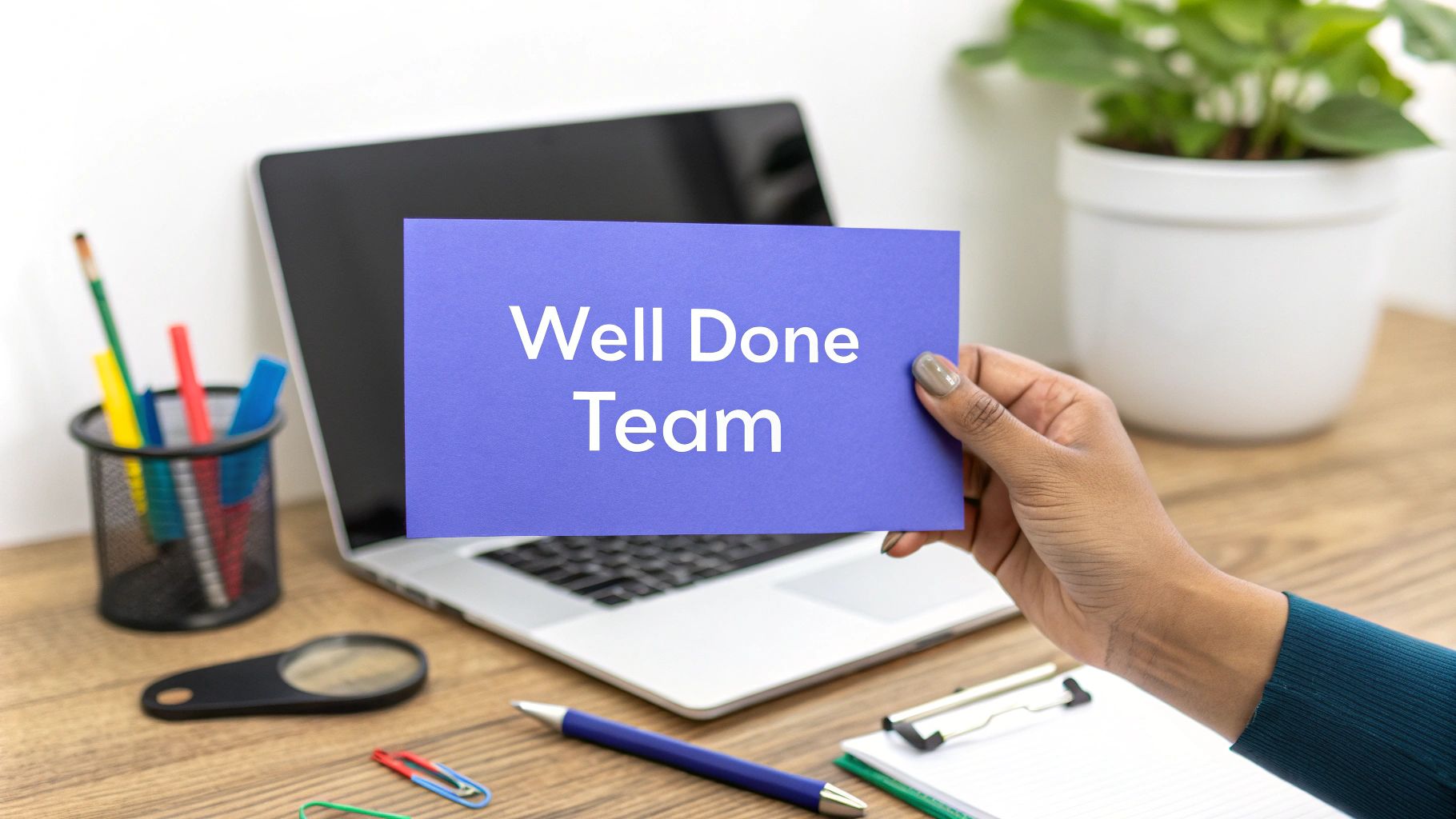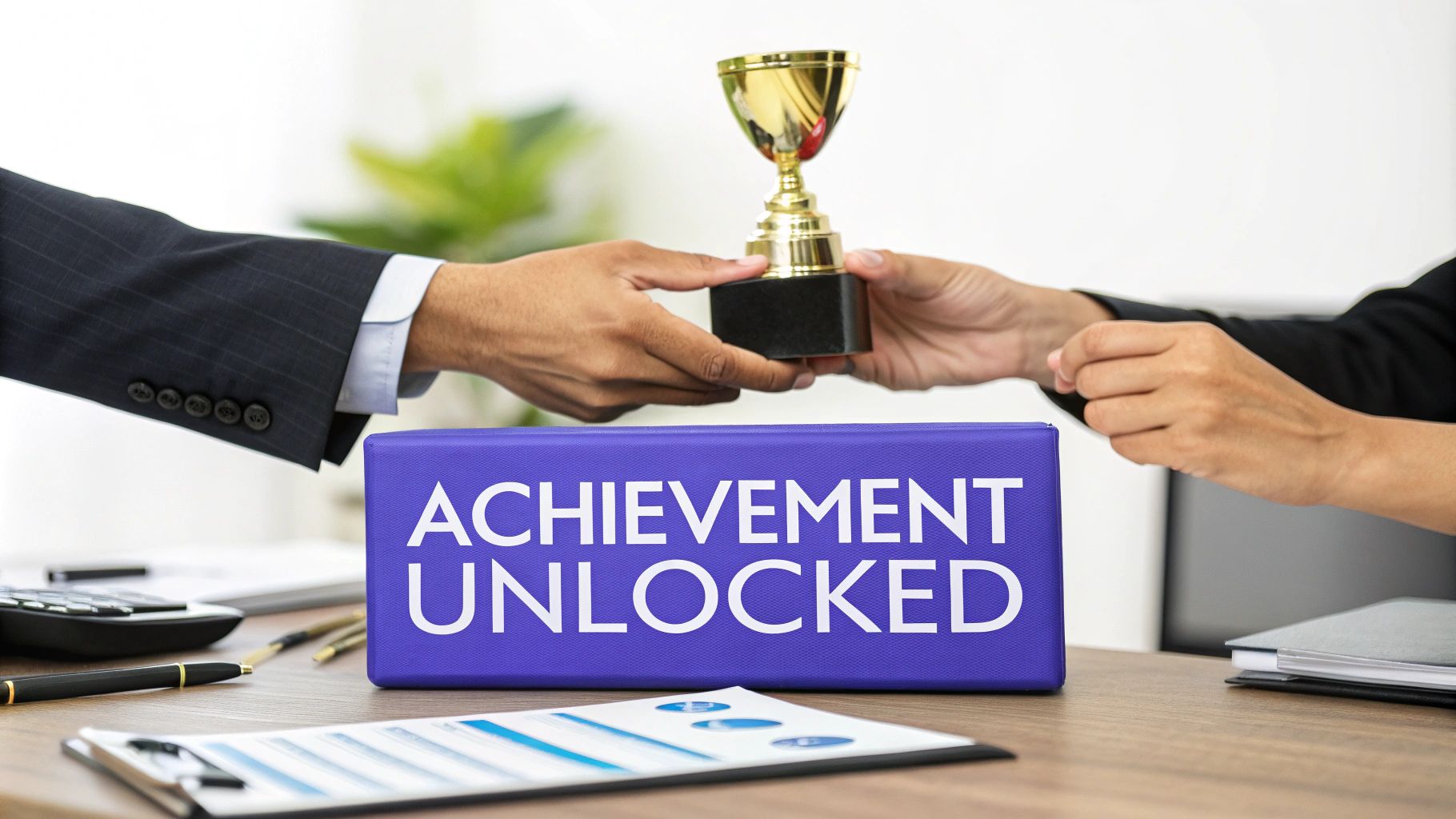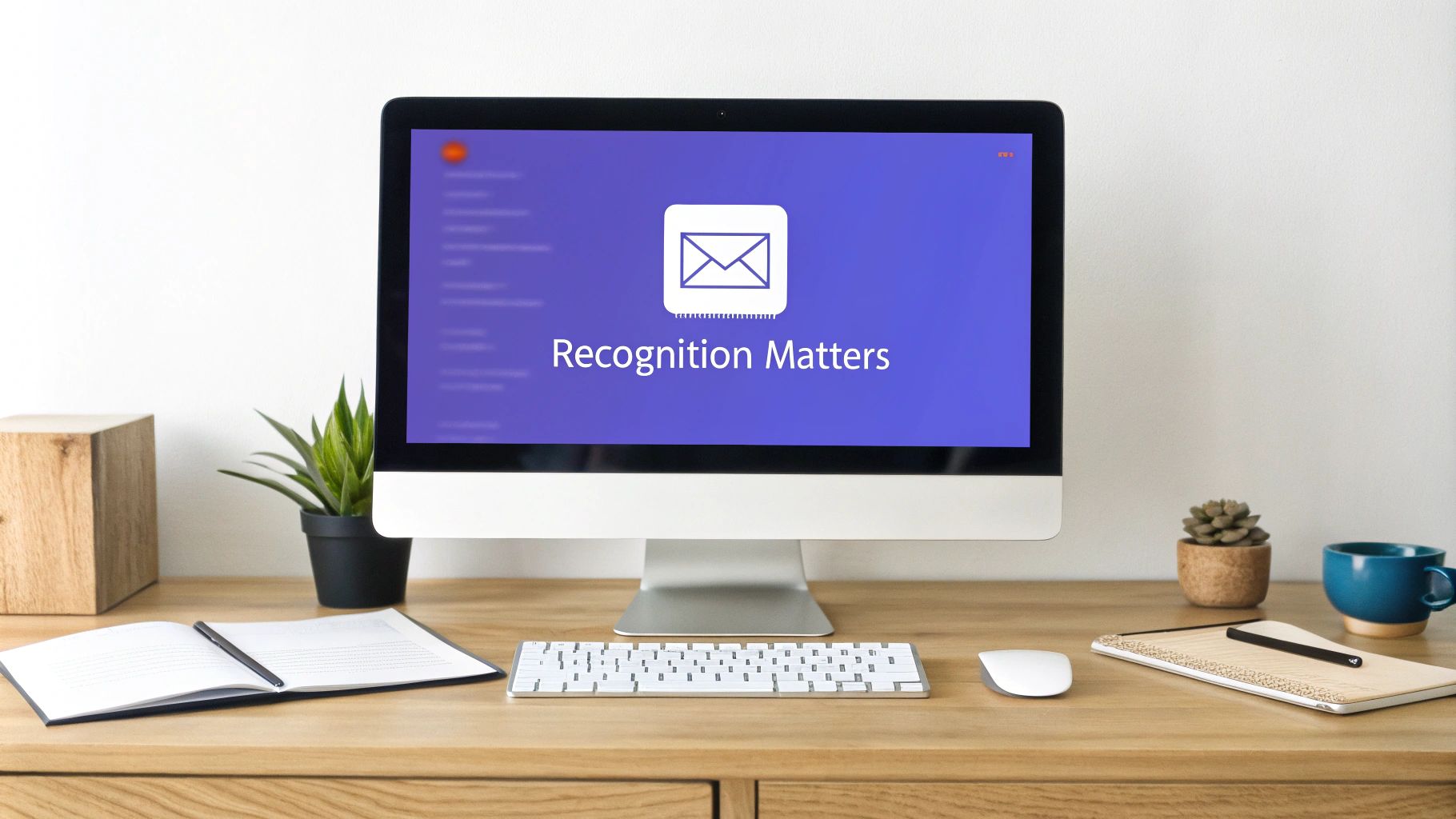How to Write Recognition Emails to Team: A Modern Guide to Employee Appreciation
The Science Behind Effective Recognition Emails

Leading teams effectively requires creating an environment where people feel valued for their contributions. A well-crafted recognition email can make a significant difference in how team members feel about their work and their place in the organization. Learning the science behind recognition helps managers tap into this powerful tool for strengthening team dynamics and improving results.
Why Recognition Matters
Research shows that 52.5% of employees want more recognition from their managers - highlighting just how much people crave acknowledgment for their efforts. When leaders provide consistent appreciation, employee engagement increases by 40%. This means that taking time to write thoughtful recognition emails isn't just a nice extra - it directly impacts performance and motivation. For instance, an employee who consistently delivers excellent work but receives little acknowledgment may gradually lose enthusiasm. However, timely recognition of their achievements through a well-written email can renew their drive and inspire them to maintain high standards.
The Impact of Strategic Recognition
Regular recognition delivers measurable benefits beyond individual motivation. Companies that make recognition a priority see engagement levels rise by 85% while reducing employee turnover by 31%. These numbers demonstrate the clear connection between showing appreciation and retaining valuable team members. Making recognition a core part of your management approach through regular emails and other forms of acknowledgment is a practical way to boost both satisfaction and business performance.
Building Recognition Into Your Leadership Style
Effective recognition should flow naturally from your leadership approach rather than feeling forced. The key is developing an eye for opportunities to acknowledge good work as it happens. After completing an important project milestone or when someone shares an innovative solution, sending a quick note of appreciation can reinforce positive contributions. Learn more about building an appreciation-focused culture in our guide on How to Improve Workplace Culture. Remember that even brief moments of recognition, when genuine and timely, strengthen team bonds and motivation. Making appreciation a consistent practice creates momentum that lifts everyone's performance. Public recognition, such as highlighting someone's achievement in a team email, can be especially powerful - it both rewards the individual and shows others what excellence looks like.
Crafting Recognition Messages That Actually Resonate

A strong culture of recognition needs more than basic thank-you notes. To make recognition meaningful, you need to understand what truly motivates people and craft messages that create genuine connections. Let's explore how to write recognition emails that make a real impact and leave lasting positive impressions on your team members.
The Psychology of Effective Recognition
The data is clear - recognition directly impacts employee engagement and motivation. Studies show that over half of employees (52.5%) want more recognition from their managers. This isn't just about being nice - consistent appreciation can boost employee engagement by 40%. When people feel genuinely valued, they become more invested in their work and contribute more to the team's success. The key is making recognition feel authentic rather than forced or generic.
Structuring Your Recognition Email to Team
A well-crafted recognition email needs three key elements: First, point to specific accomplishments rather than giving vague praise. For example, instead of just saying "great job," highlight exactly what the person did: "Your quick thinking during the server outage prevented major service disruptions." Second, explain how their work positively impacted others: "This saved our team hours of recovery time and kept our clients happy." Finally, end with sincere encouragement that shows your ongoing support. This structure helps people understand exactly what they did well and why it matters.
Adapting Your Style for Different Personalities and Achievements
Not everyone wants recognition delivered the same way. Some thrive on public praise while others prefer private acknowledgment. Pay attention to how different team members respond and adjust accordingly. For major accomplishments, you might send a formal email copying leadership. For smaller wins, a quick personal note may work better. The key is keeping the tone genuine - people can tell when praise feels forced or insincere. Match your message style to both the person and the achievement.
Examples of Resonant Recognition
Strong recognition connects specific actions to real impacts. Here's an example: "I noticed how you stayed calm under pressure during yesterday's client presentation. When technical issues came up, you smoothly worked around them while keeping everyone engaged. That kind of poise helps our whole team look professional." Another approach: "The mentoring you've provided to our new hires has helped them get up to speed incredibly fast. Their quick progress shows what a skilled teacher you are." These examples show people exactly what they did well and how it helped others. By highlighting concrete details and real outcomes, you help team members understand their value and motivate them to keep contributing their best work.
Strategic Timing for Maximum Impact

The impact of recognition emails depends heavily on when you send them. Even the most thoughtfully written message can miss its mark if it arrives at an inopportune time. Good timing helps ensure your words of appreciation land with maximum effect and truly motivate your team members.
Identifying Key Recognition Moments
Quick recognition after achievements shows you're actively noticing and valuing your team's work. For instance, sending an appreciation email right after someone completes a major project or hits an important milestone reinforces the positive impact of their contribution. Beyond big wins, acknowledging day-to-day successes like solving tricky customer issues or beating weekly targets demonstrates that you value consistent effort at all levels.
Establishing a Recognition Rhythm
While spontaneous recognition is important, creating regular touchpoints for appreciation helps build a stronger team culture. Weekly or monthly team recognition emails can work well to highlight accomplishments. Just be mindful not to overdo it - too many generic messages can feel forced and lose their meaning. The key is finding a consistent but natural cadence that keeps recognition meaningful. You might be interested in: How to master motivation within your team.
Preventing Recognition Gaps and Turnover
Research shows that 53% of employees leave their jobs due to feeling underappreciated. This stark statistic highlights why proactive recognition matters so much. Regular appreciation, especially around major milestones like work anniversaries or role changes, helps team members feel valued and connected to the organization. Making recognition a priority prevents the gaps that can lead to disengagement.
Optimizing Recognition Email Delivery
Consider your team's typical workflow when timing recognition emails. Avoid sending them late Friday afternoons or right before holidays when they may get overlooked. Mid-week mornings often work better, when people are focused and receptive. This thoughtful approach to timing shows you respect your team's attention and want your words of appreciation to resonate. Small details like this can make recognition more meaningful and impactful.
Balancing Personal and Public Recognition

When recognizing team members via email, one key decision is whether to deliver praise privately or publicly. The choice between a personal note and team-wide acknowledgment can significantly impact how the recognition is received and its effect on team morale. Finding the right mix of both approaches helps maximize the positive impact of employee appreciation.
When to Keep Recognition Private
One-on-one recognition through direct email creates meaningful personal connections and works especially well in certain situations. For instance, when acknowledging sensitive accomplishments or providing constructive feedback along with praise, private communication allows for candid discussion. A team member who overcame personal challenges affecting their work would likely appreciate discrete recognition that shows support without drawing unwanted attention. Private emails also provide space to have deeper conversations about growth and improvement.
The Power of Public Praise
Sharing recognition with the wider team through CC'd emails serves multiple valuable purposes. Public acknowledgment celebrates achievements openly, which helps create a culture where appreciation flows freely. For example, when a team member develops an innovative solution to a tough problem, highlighting their success to colleagues both rewards their contribution and inspires creative thinking in others. The ripple effects of public praise extend beyond the individual to lift the entire team.
Using CC and BCC Strategically in Recognition Email to Team
Smart use of CC and BCC options helps tailor recognition appropriately. CC works well to include the full team in celebrating accomplishments and sharing best practices. For more sensitive situations where privacy matters, BCC allows discrete recognition without broadcasting details to everyone. For instance, you might BCC someone who provided crucial behind-the-scenes support but prefers to avoid the spotlight. The key is matching the visibility level to both the situation and the person's preferences.
Aligning Recognition With Personality and Situation
Each recognition approach should fit both the individual and the specific achievement being acknowledged. Some team members flourish with public praise while others feel most valued through personal notes. The scale of the accomplishment also matters - major milestones often warrant broader recognition including leadership, while smaller wins can be meaningful through direct feedback. Understanding your team members' styles and the context helps you choose the most impactful way to show appreciation. Taking time to align recognition with personalities and situations strengthens its effect in building an encouraging work environment.
Measuring Recognition Program Success
Creating meaningful recognition programs requires more than instinct - it demands careful tracking and measurement to understand what truly works. When you invest time and resources into employee recognition, you need concrete ways to evaluate its impact. Here's how to effectively measure and improve your recognition efforts.
Key Metrics for Tracking ROI
Smart organizations carefully monitor specific indicators to assess their recognition program's effectiveness. Employee retention rates provide clear evidence of how recognition influences long-term commitment. When turnover decreases after launching consistent recognition efforts, it signals that employees feel valued and are more likely to stay. Project completion speeds and sales numbers can also demonstrate increased motivation levels. Regular satisfaction surveys round out the picture by revealing how recognition shapes team morale over time.
Gathering Meaningful Feedback
While numbers tell part of the story, direct input from employees adds essential context and nuance. Including open-ended survey questions allows team members to share detailed thoughts about which recognition approaches resonate most. This candid feedback helps identify both strengths and areas needing adjustment. For instance, employees might note that recognition feels too generic or fails to acknowledge specific contributions. Like taste-testing a recipe, this input helps refine your approach until you find the right formula.
Using Surveys and Analytics to Track Engagement
Multiple tools can help measure recognition's impact. Quick pulse surveys provide regular snapshots of team sentiment, with targeted questions like "How often do you receive meaningful recognition?" and "What types of recognition matter most to you?". More comprehensive annual engagement surveys explore recognition's influence on different aspects of work life. For organizations using recognition platforms, built-in analytics reveal patterns in how recognition flows between team members. This data highlights which approaches drive the most engagement.
Making Data-Driven Adjustments
The real value of measurement comes from using insights to improve your program. Regular review of metrics and feedback enables smart refinements. If data shows public recognition resonates strongly, you might increase team-wide celebrations. When recognition activity dips during certain periods, you can plan targeted initiatives to maintain momentum. Like a gardener responding to changing conditions, monitoring key indicators helps you nurture a thriving culture of appreciation. The key is consistently tracking what matters and adjusting your approach based on what you learn.
Recognition Templates That Drive Results
Creating meaningful recognition takes more than a simple "thank you" message. Well-crafted recognition emails make your team members feel truly valued and motivated. Here's how to use templates effectively while keeping communications authentic and impactful.
Templates for Common Scenarios
Having ready-to-use templates helps you send timely recognition while maintaining quality. Here are key examples you can customize:
Project Completion: "Subject: Kudos on the [Project Name] Success! Team, I wanted to express my sincere appreciation for your hard work and dedication in completing the [Project Name] project. Your collaborative efforts, especially [mention a specific contribution], were instrumental in achieving [mention a key result]. This success demonstrates our team's ability to [mention a positive quality, e.g., innovate under pressure, collaborate effectively]. Thank you again for your outstanding work!"
Individual Contribution: "Subject: Recognizing [Employee Name]'s Outstanding Work. Hi [Employee Name], I wanted to personally acknowledge your exceptional contribution to [mention the area, e.g., the recent sales campaign, resolving the client issue]. Your [mention specific action, e.g., quick thinking, proactive approach] made a significant difference in [mention positive outcome, e.g., exceeding our target, securing the client's satisfaction]. This kind of dedication is truly appreciated."
Milestone Achievement: "Subject: Celebrating [Employee Name]'s [Milestone]. Congratulations to [Employee Name] on reaching [Milestone, e.g., five years with the company, completing a certification]! Your dedication and growth over the past [time period] have been remarkable, and we're so fortunate to have you on the team. Here's to many more successes together!"
Adapting Templates While Maintaining Authenticity
Templates give you a starting point, but personalization is essential. Focus on specific details about each person's contributions. What exactly impressed you? Did they show particular skills or go beyond expectations? These details show you notice and value their individual efforts. Also consider each person's preferences - some enjoy public recognition while others prefer private acknowledgment.
Scaling Recognition Without Losing the Personal Touch
As teams expand, keeping recognition personal becomes more challenging. The solution isn't reverting to generic messages. Instead, create systems that support regular, meaningful recognition. This might mean using a recognition platform or setting up team-wide ways to share appreciation. Learn more in our article about how to master motivation and incentives. Remember that small, genuine acknowledgments still make an impact.
Common Pitfalls to Avoid
Watch out for these key mistakes:
- Vague Praise: Skip general comments like "good job" in favor of specific feedback about actions and impact
- Infrequent Recognition: Make appreciation a regular practice rather than a rare occurrence
- Inconsistent Recognition: Acknowledge contributions across your entire team, not just top performers
When you avoid these pitfalls and apply these strategies consistently, you build a culture where recognition drives engagement and results.